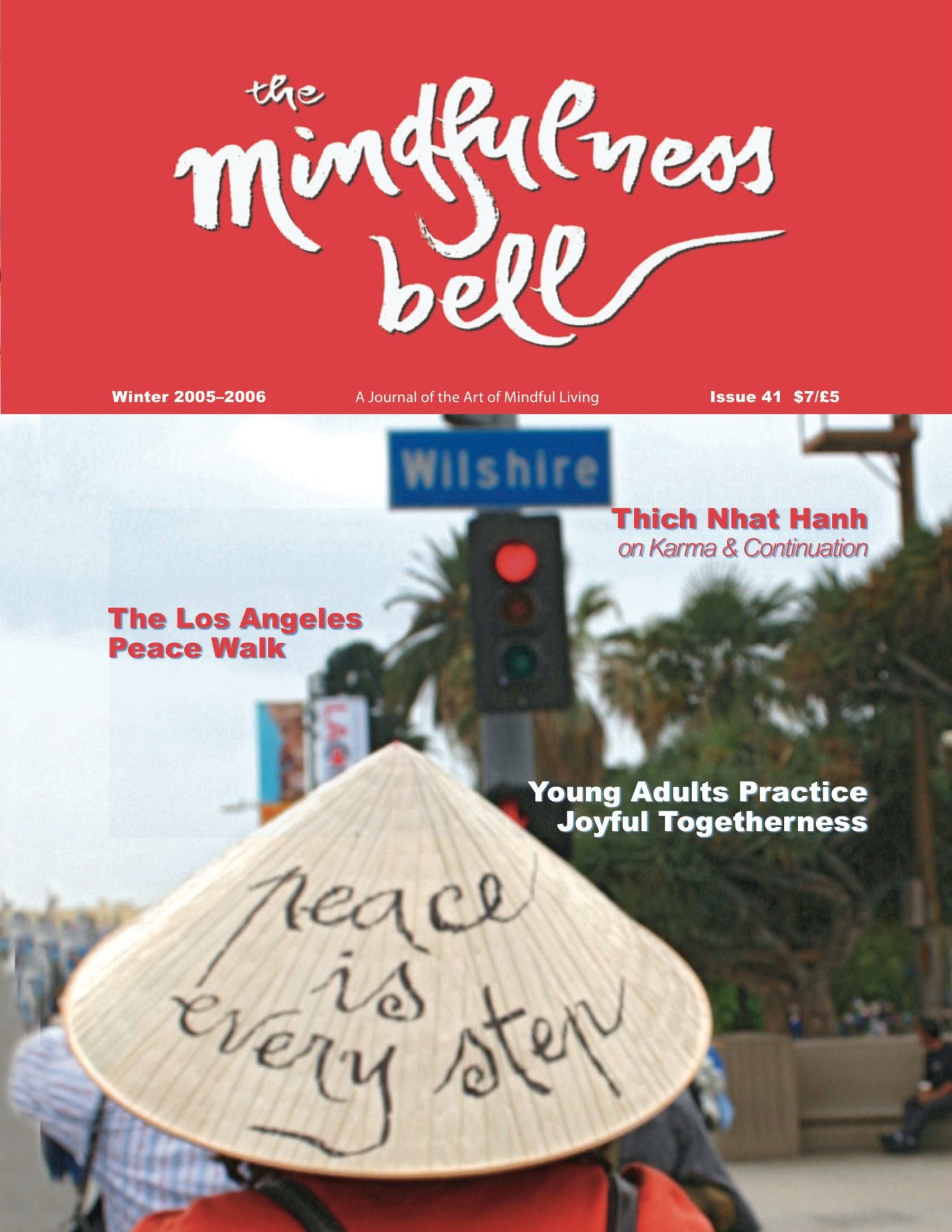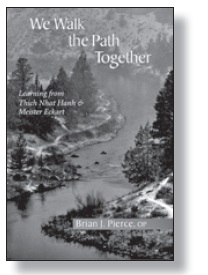
We Walk the Path Together:
Learning from Thich Nhat Hanh & Meister Eckhart
By Brian J. Pierce, O.P. Orbis Press, 2005
Reviewed by Chan Phap De
This is not another academic comparison of two great mystics; rather, it is a love affair, a meeting of two brothers in the heart of the author. Friar Brian is a Dominican monk and Zen practitioner who has been guided through his own spiritual journey by these two teachers.

We Walk the Path Together:
Learning from Thich Nhat Hanh & Meister Eckhart
By Brian J. Pierce, O.P. Orbis Press, 2005
Reviewed by Chan Phap De
This is not another academic comparison of two great mystics; rather, it is a love affair, a meeting of two brothers in the heart of the author. Friar Brian is a Dominican monk and Zen practitioner who has been guided through his own spiritual journey by these two teachers. “Permeated by the flavor of living experience,” comments Bhikshuni Annabel Laity, “this book provides a freshness of insight and the deep humility that we need on the spiritual path.”
After years of reading Thay’s books, the author was finally able to join the Plum Village community for the 2004 winter retreat. He writes, “Meeting Thay and practicing with his monastic community have been a gift that I shall never forget, and in a surprising way, it brought me face to face with Eckhart. I realized with great delight that, through the person of Thay, I was sitting at the feet of both of these beloved teachers, drinking in their teaching in a profound way.”
Focusing mainly on Thay’s teachings in Living Buddha, Living Christ and Going Home: Jesus and Buddha as Brothers, the author explores the common ground between Christianity and Buddhism, finding many intersecting points in the spiritual wisdom of Thay and Eckhart. For example, the following statement of Eckhart’s sounds like Thay: “God’s seed is in us. If it were tended by a good, wise and industrious gardener, it would then flourish all the better, and would grow up to God, whose seed it is, and its fruits would be like God’s own nature. The seed of a pear tree grows into a pear tree,...the seed of God grows to be God.”
Friar Brian credits the simplicity of Thay’s teachings on the practice of mindfulness and contemplative meditation with helping him understand the theologically rich and dense sermons of Eckhart, who, seven centuries ago, was “easily misunderstood and labeled as dangerous.” Whereas Eckhart emphatically said “What does it avail me that this birth of God is always happening, if it does not happen in me?” Thay simply says, “We are all mothers of the Buddha.” Thay also uses the birthing metaphor: “Waves are born from water. That is why we adopt the language that waves are sons and daughters of water. Water is the father of waves. Water is the mother of waves.”
Thay warns against trying to grab onto the Buddha: “You believe that going to the temple you will see the Buddha, but by doing so you are turning your back on the real Buddha.” Eckhart says, “If a person thinks that he or she will get more of God by meditation, by devotion, by ecstasies or by special infusion of grace than by the fireside or in the stable—that is nothing but taking God, wrapping a cloak around his head and shoving him under a bench. For whoever seeks God in a special way gets the way and misses God, who lies hidden in it.”
What Thomas Merton said of Eckhart can be said of Thay: “He breathed his own endless vitality into the juiceless formulas of orthodox theology with such charm and passion that the common people heard them gladly.” In this book, Friar Brian taps into the good juices seemingly hidden in the Catholic tradition. He offers meditations on subjects such as suffering, the Cross, the Trinity, baptism, the Mystical Body of Christ, equanimity and grace.
As a former priest, a current Catholic, and a “beginner” monk, I felt great joy in reading this book. It not only helped me tap more deeply into my Catholic roots, it also connected me more deeply with Thay’s teaching. Like Thay, the author has made a significant contribution to helping Christians connect with their roots and spiritual ancestors.
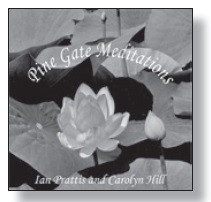
Pine Gate Meditations
By Ian Prattis & Carolyn Hill
Reviewed by Barbara Casey
The guided meditations and chants offered in this CD come from the weekly practice at Pine Gate Sangha in Ottawa, Ontario. The hour long CD contains two chants, performed by Carolyn Hill, and four guided meditations offered by Ian Prattis.
The two chants, from the Plum Village Chanting Book, are the evening chant and the incense offering (the variation that starts, “The fragrance of this incense”).
The guided meditations are each from twelve to fifteen minutes in length, making them a useful way to enjoy an extended guided meditation in solitary or in Sangha. There is a meditation on the Four Brahmaviharas, one on the Five Remembrances, an Earth meditation which helps us be in touch with our connection to Mother Earth, and an Indian based So Hum healing meditation that comes from Ian’s practice in India. Prattis’s soothing voice and the gentle background sounds of water help to bring the hearers into a state of calmness and centeredness.
Though this presentation is rooted in the tradition of Thich Nhat Hanh practice, it also offers some new ways of exploring our spiritual connections. Ian encourages us to be creative in our use of these chants and meditations, and invites us to share them with family and friends.
A practical tool for Sanghas everywhere, the Pine Gate Meditations can be purchased by check or money order to Ian Prattis and mailed to 1252 Rideout Crescent, Ottawa, Ontario, Canada K2C 2X7. Costs are $23.00 US, including shipping; $23.50 Canadian. Or contact Ian at iprattis@cyberus.ca.
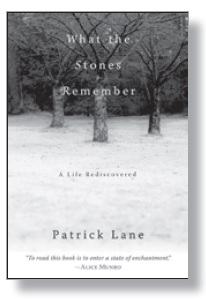
What the Stones Remember
A Life Rediscovered
By Patrick Lane Trumpeter Books, 2005
Reviewed by Barbara Casey
Patrick Lane is a recipient of most of Canada’s top literary awards and considered one of the finest poets of his generation. He has also been an alcoholic and drug addict for over forty years. This book is the story of his first year of recovery as he emerges from a rehabilitation facility.
Lane finds his salvation in his half-acre garden, and shares intimate details of the lives of the flora and fauna that are his closest friends. Month by month, we track with Lane the change of seasons in the garden, and explore his circuitous path to healing and transformation through the gentle but unyielding examination of childhood memories.
The book flows seamlessly between childhood and early adulthood memories, usually painful; brief but sharply aware observations of a body and mind coming out of a lifetime haze of addiction; and intimate observations of the natural world. But perhaps more remarkable is the honesty that comes from deeply chosen words which reflect both the beauty and the pain of this man’s story. Lane tells us what his discovery of language meant to him: “Poetry was more important to me then than food or sleep, my wife or my children. I found my place in the world with language. I was certain that with language I could heal myself and control what surrounded me. If the house should burn down what would be most important was how I would describe the flames the next day. Love for me lay in imagined places, not in the real world. Death’s only dominion was in a poem.”
Walking through these stories with Lane––sitting with him by his pond with a cup of coffee in the early morning; watching the arrival and departure of the many spiders and birds that inhabit this territory; gathering boulders at a far-off quarry––weave this man into the reader’s heart. Though the stories focus mostly on his challenging early family life and his refuge in the natural world, the brief but stark reminders of the addiction he has just stepped out of remind us of his fragility and vulnerability.
In one of the many short paragraphs that sear with the challenge of freeing oneself of addiction, he states, “This is a fearful time for me and this first morning I stare at a whirl of flies and think the mad thoughts of an alcoholic. The absence of others has always meant excess to me. Bottles of vodka clink in my mind like wind chimes. I know my sickness will abate, the sickness of drinking will slip away, but I pray to the garden that I live this one day sober.”
As the months go by, it seems that Lane goes through a softening, an increasing sensitivity to the beings in his world. One story tells of his starting to drive down the road in his pickup, only to discover a small spider in her web on the outside mirror. Knowing that increasing his speed as he approaches the highway would kill this creature, he pulls to the side of the road and finds a place to gently put her in the bushes.
The final garden project is the creation of a meditation garden. Though at first its location is surprising––in the front yard, near the road––this choice seems to represent the final stage of healing, returning to the world, centered and imperturbable.
In this remarkable book, we witness the suffering of one man, healed and transformed through a deep awareness of the world around and within him. A model for us all.
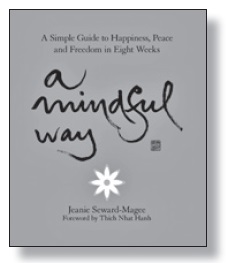
A Mindful Way
A Simple Guide to Happiness, Peace and Freedom in Eight Weeks
By Jeanie Seward-Magee Trafford Publishers, 2005
Reviewed by Constance Alexander
A Mindful Way offers an eight-week course combining mindfulness meditation with writing exercises as a means to self-exploration. The three-part program includes a daily ten-to twenty-minute sit with emphasis on breathing, two to four pages of free writing (in the tradition of Julia Cameron’s The Artist’s Way), and a nightly gratitude recollection. The layout of the book, wide margins with sidebar quotes from many traditions, makes for easy reading. The central five chapters each take one of the Five Mindfulness Trainings as their focus.
The author has practiced in Thich Nhat Hanh’s tradition for a number of years, and Thay has written an introduction to this book. All profits from the sale of the book go to support Plum Village.
As a practitioner for four years, I decided to undertake this program as a way to deepen my own practice. I like to write—a bonus, given the many writing exercises. For those of us in a post-therapy era of our lives, going back to write about childhood and family may feel like “been there/done that.” However, the author raises enough interesting questions to keep one writing; for example, “Describe your life for the past ten years, but do it as though it’s ten years from now.” Talk about confronting all your hopes, dreams, and fears of the future!
I also enjoyed taking time before bed to remember five things for which I was grateful that day. I realized how often I prepared for sleep feeling vaguely dissatisfied. Remembering the small treasures of the past twenty-four hours and writing them down helped recast things in a brighter light. That little gratitude book became my reverse “to do” list—instead of guiltily reviewing what I hadn’t “crossed off my list,” I could refer to the list of blessings which had been heaped on me (many of which, I realized gratefully, were out of my control).
The author recommends that anyone using this book, if not already in a spiritual community, join with like-minded friends for this eight week journey. I agree. Sharing what arises will sustain and enrich the experience. In the early days of my practice, I dreaded reading the Five Mindfulness Trainings as, coming out of a strict religious background, I tended to see them as the Five Commandments (think stone tablets backlit with flashes of lightning!). It was only in sitting and sharing with my Sangha that I learned the beauty of the Trainings.
The author’s personal reflections, the stories she shares from her life, are an integral part of A Mindful Way. For me, these are sometimes not quite on target as illustrations of her point. This cavil aside, I found A Mindful Way a useful practice tool. It is an ambitious book, seeking to combine a spiritual guide with a more conventional self-help manual. But as such, it may also garner readers who would not otherwise pick up one of Thay’s books. There are many doorways to the practice.
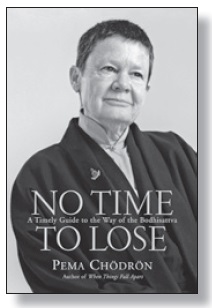
No Time to Lose
A Timely Guide to the Way of the Bodhisattva
By Pema Chödrön Shambhala Publications, 2005
Reviewed by Judith Toy
The night the Buddha died in the tiny village of Kusinara, nearly three hundred bhikkhus lit torches. Until dawn they told stories of the Buddha’s life in the presence of his body in repose, while sal blossoms floated to earth. It was as if the torches symbolized the light of the Buddha himself entering the bodies of his disciples. Pema Chödrön has lit such a torch for us with her book, No Time to Lose, A Timely Guide to the Way of the Bodhisattva, her commentary on the Tibetan Buddhist classic, Guide to the Bodhisattva’s Way of Life (Bodhisattvacharyavatara) by Shantideva, an eighth-century Buddhist master from the monastic university of Nalanda, India. The author calls Shantideva’s work “a rhapsody on the wonders of bodhicitta,” the mind of love.
Translated by the Padmakara Translation Group into quatrains with the accessible cadence of iambic pentameter, Shantideva’s words sing: And may the naked now be clothed,/And all the hungry eat their fill./And may those parched with thirst receive/ Pure waters and delicious drink.(10.19) Shining the light of her wisdom on small groups of stanzas, Chödrön brings the twelvecentury old teachings home to present-day Westerners.
The emphatic and pragmatic title gives us a no-nonsense summons to get down to business in our own life and practice. Shantideva and Chödrön encourage us to use our lives to water seeds of love. As we set out on the bodhisattva path to free endless beings from their suffering, Chödrön offers, “Everything we encounter becomes an opportunity to develop the outrageous courage of the bodhi heart.” The authors repeatedly remind us to fall back on our essential Buddha nature.
Chödrön offers a helpful study guide at the end, which is useful while reading. Our Sangha’s aspirants to the Order of Interbeing will use this book as they enter the bodhisattva path. Compared to two previous translations of Shantideva, I found this one the most helpful for its rhythmic, poetic translation and for Chödrön’s down-to-earth commentary. Allen Ginsberg’s translation of the last famous lines of the Heart Sutra captures for me the imperative of this book: “Gone, gone, to the other shore gone, reach (go) enlightenment accomplish!”

